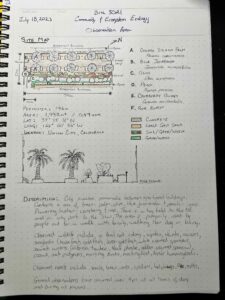Location: Small urban community space/park next to my apartment in Union City, California.
Observed on: July 18, 2023 at 11:00AM
Season: Summer
Temp: 21C
Weather: Sunny
Wind: 13km
Humidity: 64%
Plant hardiness zone: 9b
Ecosystem: Urban park bordering dry agriculture/grass land
Description: The selected area is a 1/2 acre promenade (walking path) located between 2 apartment buildings. To the NE, there is a train track and a 26 acre hay field. To the SE there is an urban jungle gym and a small city park with a fountain. The promenade is a flat concrete path (7m x 74m) surrounded by a mix of planted trees and shrubs including: palm, olive, blue jacaranda, a peach tree, crossberry bushes and rose bushes (see journal image for plant locations). The area is primarily used by people going for walks with family, walking their dogs, riding bikes, and sitting on benches.
Over the last 4 years, I have observed the following wildlife: a feral cat colony, coyotes, skunks, racoons, squirrels, songbirds (house finch, gold finch, lesser goldfinch, white crowned sparrows, Bewick wrens, California towhee, black phoebe, golden crowned sparrow, red crested sparrow), crows, pigeons, morning doves, mockingbirds, and Anna’s hummingbirds. Observed insects include: snails, bees, ants, spiders, ladybugs, flies, moths.
Question 1: What is the impact of the feral cat colony on the bird population considering that the cats are well fed by the local residents?
Question 2: What is the distribution of the snail population, ie. Ground/bush/tree?
Question 3: How often does the cat food attract wild animals to the area?

Great field journal! I was unsure about your choice of location at the start of your post as it is not very large though you have a surprisingly large number of species observations. As you work through the next couple of modules you will get a sense of what questions might work for this course and you can build an experimental design. Question #2 has a lot of potential. I always encourage students with limited spatial area to think of smaller study subjects as it allows for more replicates. Your question #3 about food is a tricky one. You can not feed or modify any existing feeding of animals for this course as any study that requires manipulation of animals requires animal care approval.
Thank you for the feedback.